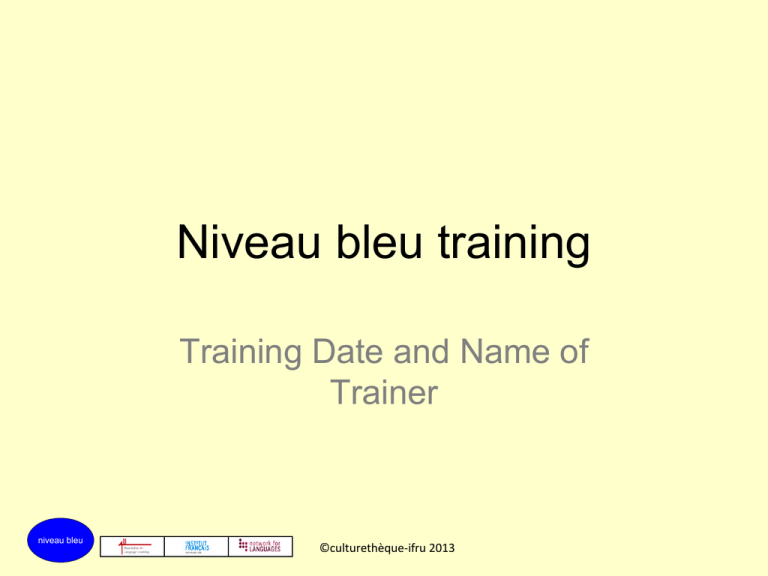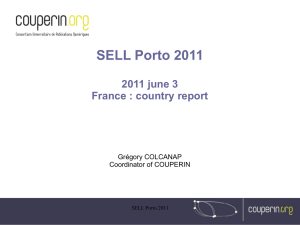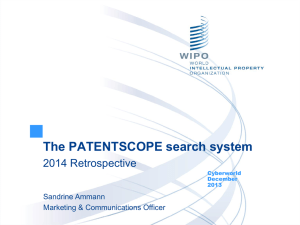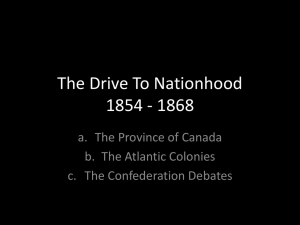Primary French Project Training
advertisement

Niveau bleu training Training Date and Name of Trainer niveau bleu ©culturethèque-ifru 2013 PRIMARY FRENCH PROJECT PARTNERSHIP Projet de français pour le Primaire Primary French Project niveau bleu ©culturethèque-ifru 2013 2 The Primary French Project The Primary French Project is a collaboration between •The Association for Language Learning (ALL) •Network for Languages •Institut français du Royaume-Uni (IFRU) The purpose of the Primary French Project is to support any primary school in the UK that wishes to teach French throughout Key Stage 2 as part of the statutory curriculum. niveau bleu ©culturethèque-ifru 2013 3 The Primary French Project French teaching materials for use in the KS2 classroom have the following aims: to exemplify the Programme of Study for Languages in Key Stage 2 to train teachers with little or no knowledge of French (language and methodology) niveau bleu ©culturethèque-ifru 2013 4 The Primary French Project The materials support all teachers of French in KS2 by: providing class teaching materials that develop the teacher’s subject knowledge (French language and culture); saving planning time - all materials include half-termly planning and weekly lesson plans; saving preparation time - all materials include easy-to-use PowerPoint presentations to enable teachers to deliver each lesson through the interactive whiteboard, together with printable picture cards and word cards, and links to French story books on line; providing exemplification of the Programme of Study for Languages in KS2, with strong links to literacy; providing a scaffolding for linguistic progression throughout KS2. niveau bleu ©culturethèque-ifru 2013 5 Primary French Project Training Although the Primary French Project materials can be used to teach children, their core purpose is to be a mechanism that trains the teacher. niveau bleu ©culturethèque-ifru 2013 6 Primary French Project Training By using the materials to teach children, the teacher’s subject knowledge is developed in terms of vocabulary, linguistic progression, grammar, pronunciation, intonation and spelling, as well as cultural knowledge. niveau bleu ©culturethèque-ifru 2013 7 Primary French Project Training Primary French training is developed over a minimum of four years, starting with niveau bleu, then moving on to niveau blanc, niveau rouge and niveau tricolore. niveau bleu Y6 niveau tricolore Y5 niveau rouge Y4 niveau blanc Y3 niveau bleu ©culturethèque-ifru 2013 8 Primary French Project Training A complete course of KS2 French training comprises: 1st year of training - use niveau bleu materials to teach children in year 3; 2nd year of training - use niveau blanc materials to teach children in year 4; 3rd year of training - use niveau rouge materials to teach children in year 5; 4th year of training - use niveau tricolore materials to teach children in year 6. niveau bleu ©culturethèque-ifru 2013 Y6 niveau tricolore Y5 niveau rouge Y4 niveau blanc Y3 niveau bleu 9 Primary French Project Training Primary French training at each level is achieved as the teacher uses the materials for a minimum of one school year for: planning delivery assessment niveau bleu ©culturethèque-ifru 2013 10 Primary French Project Training Training for secondary teachers is identified as niveau multicolore, and this is designed to help secondary teachers to understand the primary experience and to build upon it in Key Stage 3 and beyond. niveau bleu ©culturethèque-ifru 2013 niveau multicolore KS2 KS3 11 Primary French Project Training Training at each level begins when the Primary French materials are introduced by means of a one-day course to teachers, subject leaders, headteachers, governors, advisors or trainers. niveau bleu ©culturethèque-ifru 2013 Y6 niveau tricolore Y5 niveau rouge Y4 niveau blanc Y3 niveau bleu 12 Primary French Project Training The materials can then be disseminated and used in schools by any practitioner or trainer who has attended the initial training day, or who has been introduced to the materials by a colleague who has attended the initial training day. niveau bleu ©culturethèque-ifru 2013 Y6 niveau tricolore Y5 niveau rouge Y4 niveau blanc Y3 niveau bleu 13 Primary French Project Training The introductory training days are run throughout the country by Network for Languages. For details of training events in your region, please see www.culturetheque.org.uk, or contact your local Network for Languages Centre. niveau bleu ©culturethèque-ifru 2013 14 Primary French Project Training Primary schools are strongly encouraged to become members of the Association for Language Learning. ALL Primary Hubs across the country will offer focussed support that can help teachers to further develop their subject knowledge, and their confidence in the classroom. niveau bleu ©culturethèque-ifru 2013 15 Primary French Project Accreditation Delegates who attend the introductory training day receive an attendance certificate. Teachers who use the materials as recommended, to teach French to children throughout a whole school year, may download a certificate, as evidence that they have completed the training at the corresponding level. niveau bleu ©culturethèque-ifru 2013 16 Primary French Project Training KS2 practitioners should start at niveau bleu level, before moving on to niveau blanc, niveau rouge and niveau tricolore. niveau bleu Y6 niveau tricolore Y5 niveau rouge Y4 niveau blanc Y3 niveau bleu ©culturethèque-ifru 2013 17 Primary French Project Training The full length of training for KS2 French is a minimum of four years. Full training in one level or “niveau” should be completed before moving to the next level. For example, teachers should complete niveau bleu before embarking on niveau blanc. niveau bleu Y6 niveau tricolore Y5 niveau rouge Y4 niveau blanc Y3 niveau bleu ©culturethèque-ifru 2013 18 Training Log A downloadable log and a digital information pack are currently being developed and will be available on Culturethèque from June 2014. The log will help schools to provide evidence of training and development in terms of primary French teaching. niveau bleu ©culturethèque-ifru 2013 19 Continuity KS2-KS3 Training and support for secondary teachers of French will be offered as part of the project, to enable secondary teachers to build on children’s prior learning. This level of training is known as niveau multicolore. niveau bleu niveau multicolore ©culturethèque-ifru 2013 KS2 KS3 20 Continuity KS2-KS3 A similar log for secondary schools will be downloadable from Culturethèque from Autumn 2014. The log will help secondary MFL departments to show how they are building upon children’s prior learning in French. niveau bleu niveau multicolore ©culturethèque-ifru 2013 KS2 KS3 21 Culturethèque The Primary French Project materials are all downloadable from the Culturethèque website. The Training Logs will also be there from Autumn 2014. niveau bleu Partner Roles ©culturethèque-ifru 2013 22 Email primaryfrench@institutfrancais.org.uk niveau bleu ©culturethèque-ifru 2013 23 Purpose of PFF materials 1 To exemplify the Programme of Study, including progression in each year group, and throughout Key Stage 2 niveau bleu ©culturethèque-ifru 2013 24 Purpose of PFF materials 2 To train the teacher by developing knowledge of the French language and how to teach it in Key Stage 2 • save planning time by providing easy-tofollow lesson plans niveau bleu ©culturethèque-ifru 2013 25 Purpose of PFF materials 2 To train the teacher by developing knowledge of the French language and how to teach it in Key Stage 2 • save preparation time by providing easy-to-use PowerPoint presentations for the whiteboard that include images and voice recordings niveau bleu ©culturethèque-ifru 2013 26 Purpose of PFF materials 2 To train the teacher by developing knowledge of the French language and how to teach it in Key Stage 2 • support practitioners who have little or no subject knowledge, by providing planning and teaching materials that will help to build subject knowledge niveau bleu ©culturethèque-ifru 2013 27 Purpose of PFF materials 2 To train the teacher by developing knowledge of the French language and how to teach it in Key Stage 2 • support practitioners with little or no knowledge of French by including all necessary sound recordings niveau bleu ©culturethèque-ifru 2013 Bonjour, Nounours ! 28 Purpose of PFF materials 2 To train the teacher by developing knowledge of the French language and how to teach it in Key Stage 2 • provide user-friendly teaching materials in short lessons (15 mins) – not daunting - will not demand much time in a busy curriculum niveau bleu ©culturethèque-ifru 2013 29 Purpose of PFF materials 2 To train the teacher by developing knowledge of the French language and how to teach it in Key Stage 2 • provide what is necessary to enable the teacher to start teaching French niveau bleu ©culturethèque-ifru 2013 30 niveau bleu • for practitioners who haven’t yet started • materials exemplify PoS for KS2 children starting French, or in year 3 niveau bleu Y6 niveau tricolore Y5 niveau rouge Y4 niveau blanc Y3 niveau bleu ©culturethèque-ifru 2013 31 Transition KS2-KS3 • Secondary languages teachers will also be supported by the Primary French Project • Martine Pillette will run training to support transition niveau bleu ©culturethèque-ifru 2013 niveau multicolore KS2 KS3 32 Programme of Study Languages – Purpose of Study Learning a foreign language is a liberation from insularity and provides an opening to other cultures. A highquality languages education should foster pupils’ curiosity and deepen their understanding of the world. niveau bleu ©culturethèque-ifru 2013 33 Programme of Study Languages – Purpose of Study The teaching should enable pupils to express their ideas and thoughts in another language and to understand and respond to its speakers, both in speech and in writing. niveau bleu ©culturethèque-ifru 2013 34 Programme of Study Languages – Purpose of Study It should also provide opportunities for them to communicate for practical purposes, learn new ways of thinking and read great literature in the original language. niveau bleu ©culturethèque-ifru 2013 35 Programme of Study Languages – Purpose of Study Language teaching should provide the foundation for learning further languages, equipping pupils to study and work in other countries. niveau bleu ©culturethèque-ifru 2013 36 Programme of Study Languages – Aims The national curriculum for languages aims to ensure that all pupils: understand and respond to spoken and written language from a variety of authentic sources speak with increasing confidence, fluency and spontaneity, finding ways of communicating what they want to say, including through discussion and asking questions, and continually improving the accuracy of their pronunciation and intonation can write at varying length, for different purposes and audiences, using the variety of grammatical structures that they have learnt discover and develop an appreciation of a range of writing in the language studied. niveau bleu ©culturethèque-ifru 2013 37 Programme of Study Subject Content – KS2 Teaching may be of any modern or ancient foreign language and should focus on enabling pupils to make substantial progress in one language. The teaching should provide an appropriate balance of spoken and written language and should lay the foundations for further foreign language teaching at key stage 3. niveau bleu ©culturethèque-ifru 2013 38 Programme of Study Subject Content – KS2 It should enable pupils to understand and communicate ideas, facts and feelings in speech and writing, focused on familiar and routine matters, using their knowledge of phonology, grammatical structures and vocabulary. niveau bleu ©culturethèque-ifru 2013 39 Programme of Study Subject Content – KS2 • The focus of study in modern languages will be on practical communication. If an ancient language is chosen the focus will be to provide a linguistic foundation for reading comprehension and an appreciation of classical civilisation. Pupils studying ancient languages may take part in simple oral exchanges, while discussion of what they read will be conducted in English. A linguistic foundation in ancient languages may support the study of modern languages at key stage 3. niveau bleu ©culturethèque-ifru 2013 40 Pupils should be taught to Programme of Study • listen attentively to spoken language and show understanding by joining in and responding Using the niveau bleu materials, teachers are given opportunities to help children achieve the following objectives: listen attentively to language spoken by the teacher, modelled by voice recordings from the whiteboard, audio CDs or DVD. practise using vocabulary and structures introduced through the whiteboard, picture cards, text cards and real objects. show understanding using non-verbal physical response (e.g. responding to classroom instructions); by speaking in chorus (listening and repeating); by speaking alone (listening and repeating); by asking and answering questions in chorus or individually in whole-class context, or in pairs or small groups). niveau bleu ©culturethèque-ifru 2013 41 Pupils should be taught to Programme of Study • explore the patterns and sounds of language through songs and rhymes and link the spelling, sound and meaning of words Using the niveau bleu materials, teachers are given opportunities to help children achieve the following objectives: ask how something is spelt be able to spell certain words, such as names of capital cities. listen to stories, and join in with finger rhymes and songs. identify the phoneme [y] and its grapheme ‘u’. identify the phoneme [ɛ]̃ and its grapheme ‘un’. identify the phoneme [e] and its graphemes ‘é’, ‘er’ and ‘ez’. know that the final consonant in a word is usually silent, e.g. Paris, Irlande du Nord, Pays de Galles. find out about vowels and consonants in French, English and Welsh find out about the ligature ‘œ’ and be able to identify it when you see and hear it know that the circumflex accent can appear over any vowel know that the circumflex accent can show that historically there used to be a double vowel, or that a consonant has disappeared from the word. know that the acute accent appears only over the letter ‘e’, and changes the pronunciation of the 42 niveau bleu ©culturethèque-ifru 2013 letter. Pupils should be taught to Programme of Study • engage in conversations; ask and answer questions; express opinions and respond to those of others; seek clarification and help Using the niveau bleu materials, teachers are given opportunities to help children achieve the following objectives: exchange greetings with the teacher, other adults and children. understand and give personal information such as name, age and where you live. ask and answer questions about capital cities, e.g. Quelle est la capitale de la France ? be able to use the response words Oui and Non be able to understand questions using C’est + noun? be able to answer questions using Oui or Non, coupled with c’est + noun. be able to ask and answer questions using number labels niveau bleu ©culturethèque-ifru 2013 43 Pupils should be taught to Programme of Study • speak in sentences, using familiar vocabulary, phrases and basic language structures Using the niveau bleu materials, teachers are given opportunities to help children achieve the following objectives: be able to use templates to create spoken sentences about landmarks in Belfast, Cardiff, Edinburgh, London and Paris. be able to use a speaking frame to ask and answer a variety of questions be able to form spoken sentences about Paris and cities across the UK, using an adverbial opener, a verb, nouns and a conjunction. niveau bleu ©culturethèque-ifru 2013 44 Pupils should be taught to Programme of Study • develop accurate pronunciation and intonation so that others understand when they are reading aloud or using familiar words and phrases Using the niveau bleu materials, teachers are given opportunities to help children achieve the following objectives: understand the importance of accurate pronunciation and intonation. know that intonation describes how we can use our voice to help convey meaning in a sentence, and can highlight aspects of grammatical structure. know that a statement can be turned into a question using tone of voice. niveau bleu ©culturethèque-ifru 2013 45 Pupils should be taught to Programme of Study • present ideas and information orally to a range of audiences Using the niveau bleu materials, teachers are given opportunities to help children achieve the following objectives: be able to exchange personal information, and talk about familiar places, in pairs and small groups, in front of the class, or to a larger group such as in school assembly. niveau bleu ©culturethèque-ifru 2013 46 Pupils should be taught to Programme of Study • read carefully and show understanding of words, phrases and simple writing. Using the niveau bleu materials, teachers are given opportunities to help children achieve the following objectives: read aloud familiar vocabulary and structures, with accurate pronunciation and intonation. read and understand short texts containing familiar vocabulary and structures, e.g. aspects of personal information, and descriptions of places. niveau bleu ©culturethèque-ifru 2013 47 Pupils should be taught to Programme of Study • appreciate stories, songs, poems and rhymes in the language Using the niveau bleu materials, teachers are given opportunities to help children achieve the following objectives: listen to stories, and take part in finger rhymes and songs. niveau bleu ©culturethèque-ifru 2013 48 Pupils should be taught to Programme of Study • broaden their vocabulary and develop their ability to understand new words that are introduced into familiar written material, including through using a dictionary. Using the niveau bleu materials, teachers are given opportunities to help children achieve the following objectives: know that a bilingual dictionary contains equivalent words in two languages. know that, in a dictionary, headwords are listed in alphabetical order. know how to sort words into alphabetical order by their first letter. niveau bleu ©culturethèque-ifru 2013 49 Pupils should be taught to Programme of Study • write phrases from memory, and adapt these to create new sentences, to express ideas clearly Using the niveau bleu materials, teachers are given opportunities to help children achieve the following objectives: use a template or picture clues to write sentences and short texts, e.g. brief details of personal information and descriptions of places. niveau bleu ©culturethèque-ifru 2013 50 Pupils should be taught to Programme of Study • describe people, places, things and actions orally* and in writing Using the niveau bleu materials, teachers are given opportunities to help children achieve the following objectives: be able to give brief details of personal information orally and in writing. be able to describe countries, cities and landmarks orally and in writing. niveau bleu ©culturethèque-ifru 2013 51 Pupils should be taught to Programme of Study • understand basic grammar appropriate to the language being studied, including (where relevant): feminine, masculine and neuter forms and the conjugation of high-frequency verbs; key features and patterns of the language; how to apply these, for instance, to build sentences; and how these differ from or are similar to English. Using the niveau bleu materials, teachers are given opportunities to help children achieve the following objectives: •be able to apply punctuation correctly: comma, full stop and question mark. •know that, in written sentences, a comma is used to separate words in a series, and to represent intonation present in spoken language. •know that the first word in a sentence is given a capital letter. •know that the names of towns, countries, rivers, landmarks and people are given a capital letter. •know that nouns are types of words that can name people, places or things. •know that a proper noun is a name given to individual people or places. •be familiar with a range of proper nouns, e.g. la France, Paris, Nora, la Seine. •understand that a verb can express an action or a state of being in a sentence •be able to use certain verbs in sentences: the verb il y a; part of the verb ‘to be’ in the phrase C’est…? and C’est… ; verbs in questions and statements about personal information, e.g. Je m’appelle Nounours, j’habite à Paris, j’ai sept ans. niveau bleu ©culturethèque-ifru 2013 52 Pupils should be taught to Programme of Study • understand basic grammar appropriate to the language being studied, including (where relevant): feminine, masculine and neuter forms and the conjugation of high-frequency verbs; key features and patterns of the language; how to apply these, for instance, to build sentences; and how these differ from or are similar to English. Using the niveau bleu materials, teachers are given opportunities to help children achieve the following objectives: •understand that an adverb is a word or phrase that tells us more about the time, place or manner of the action described in the rest of the sentence; it tells us more about the verb. •be able to use an adverbial phrase as a sentence opener, e.g. À Paris, À Londres; •understand that when an adverbial phrase is used as a sentence opener, it must be followed by a comma. •be able to use the adverb aussi. •know that a conjunction can link together two words or phrases. •be able to use the conjunctions ou and et to link words or phrases. •know which preposition to use when talking about countries, e.g. en France, au Pays de Galles. •be able to identify the definite article le, la, l’, les. niveau bleu ©culturethèque-ifru 2013 53 Niveau bleu training aims • Exemplify new PoS KS2 (not a SoW) • Support teachers / practitioners with little or no French (learn the language as you teach) • Support teachers / practitioners with excellent French to teach in an ageappropriate way (Vygotsky – see through eyes of the children) niveau bleu ©culturethèque-ifru 2013 54 Niveau bleu training aims • Not daunting in terms of language competence or confidence • Each lesson 15 mins x2 (Little time in the curriculum) • Half Term: 5 lessons, 1 story, 1 song, 1 finger rhyme niveau bleu ©culturethèque-ifru 2013 55





